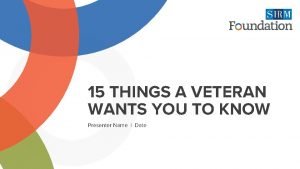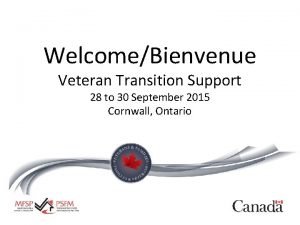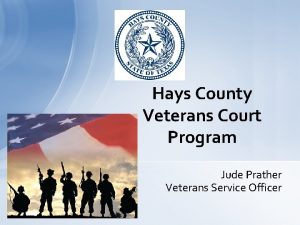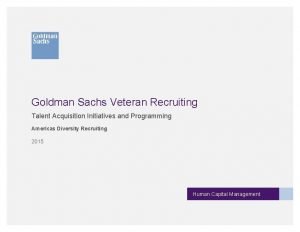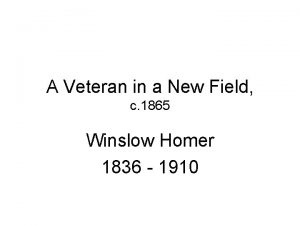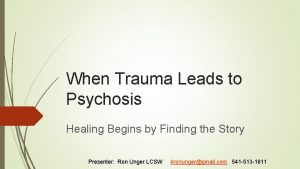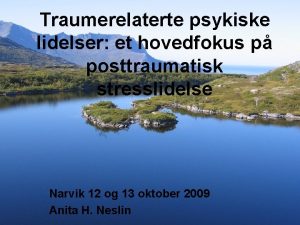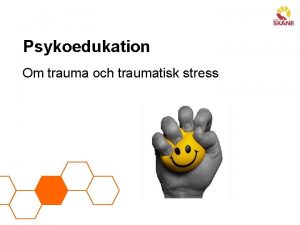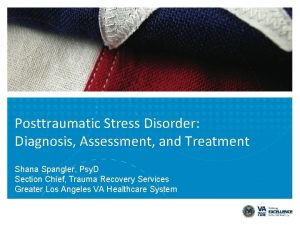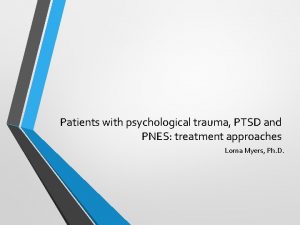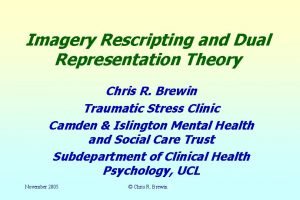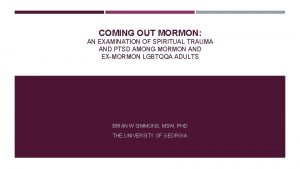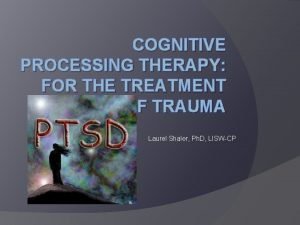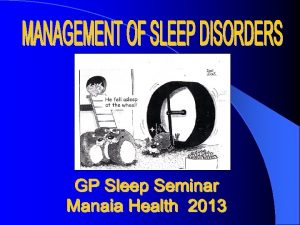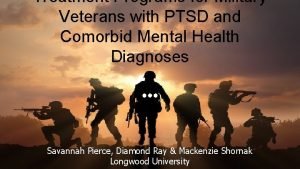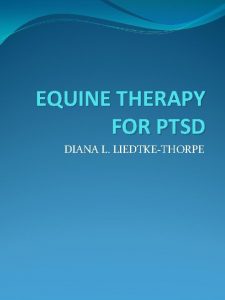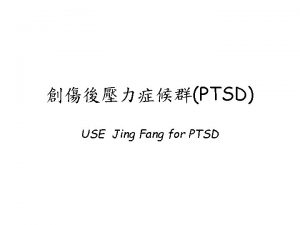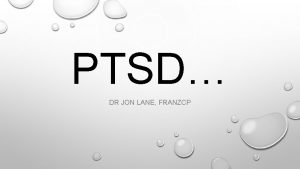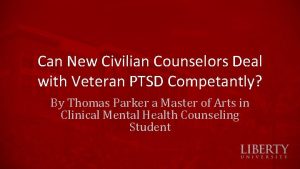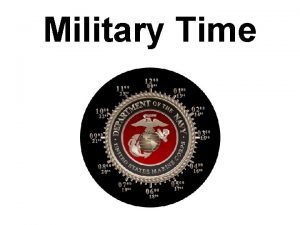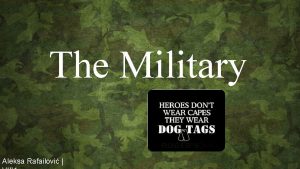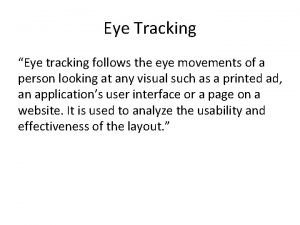Military Veteran PTSD Treatment How does eye movement
















- Slides: 16

Military Veteran PTSD Treatment: How does eye movement desensitization and reprocessing therapy compare to prolonged exposure therapy? Capstone Project, MPAS 218 Jamie Romero PA-S April 3, 2020

Disclosure I have NO financial interest/ arrangement, affiliation or conflict of interest with any organization showcased within the material of this presentation. The intended purpose of this presentation is to complete the University of the Pacific Physician Assistant program Capstone project.

What is Post Traumatic Stress Disorder (PTSD)? • Posttraumatic stress disorder is a psychiatric disorder that can occur in people who have experienced or witnessed a traumatic event such as a natural disaster, a serious accident, a terrorist act, war/combat, rape or other violent personal assault. –American Psychiatric Association • DSM V Criteria • Criterion A (1) • Criterion B (1) • Criterion C (1) • Criterion D (2) • Criterion E (2) • Criterion F-H (req’d)

PTSD History • How far back does PTSD go? • Evolution of PTSD and treatment • Modern Day perspective

PICOT Question • In _military veterans with PTSD_(P), how does _eye movement desensitization and reprocessing therapy_ (I) compared to _prolonged exposure therapy_(C) affect __treatment success rates__(O) ?

Prolonged exposure therapy • Utilizes 4 areas: – – Education Exposure Imagination and recall Emotional preparation • Goal – Habituation

Eye Movement Desensitization and Reprocessing • Utilizes an 8 phase process: • History • Preparation • Assessment • Desensitization • Goal • • Installation Body scan Closure Reevaluation

Findings • Literature search • Variations • Similarity • Complications • Contribution to PICOT question

PCL-M INSTRUCTIONS: Below is a list of problems and complaints that veterans sometimes have in response to stressful military experiences. Please read each one carefully, then circle one of the numbers to the right to indicate how much you have been bothered by that problem in the past month. 1. Repeated, disturbing memories, thoughts, or images of a stressful military experience? 2. Repeated, disturbing dreams of a stressful military experience? 3. Suddenly acting or feeling as if a stressful military experience were happening again (as if you were reliving it)? 4. Feeling very upset when something reminded you of a stressful military experience? 5. Having physical reactions (e. g. , heart pounding, trouble breathing, sweating) when something reminded you of a stressful military experience? 6. Avoiding thinking about or talking about a stressful military experience or avoiding having feelings related to it?

Study • March 2009 -February 2012 • Sample Size • 331 members meeting criteria for PTS • EMDR vs Other Therapy(s) • Assessment

Study Results • Difference between groups • 63% had a 10 point improvement on their PCL-M • Comparison to those who did not receive EMDR • 40% improvement • Fewer sessions • Why? • Autonomy • Verbal recall • Alternating bilateral body stimulus

Unanswered Questions, Gaps and Future suggestions • Prolonged exposure therapy (longevity) • Participation • Standardization • New initiates or improved therapies • Long-term • Regression • Future wars

Conclusion • Variation • Treatment options • One Size does not fit all • Treatment methods with positive results

References • Andreasen NC. What is post-traumatic stress disorder? . Dialogues Clin Neurosci. 2011; 13(3): 240– 243. • VA. gov: Veterans Affairs. History of PTSD in Veterans: Civil War to DSM-5. https: //www. ptsd. va. gov/understand/what/history_ptsd. asp. Published October 17, 2019. Accessed November 23, 2019. • Crocq MA, Crocq L. From shell shock and war neurosis to posttraumatic stress disorder: a history of psychotraumatology. Dialogues Clin Neurosci. 2000; 2(1): 47– 55. • Caselli I, Poloni N, Ielmini M, Diurni M, Callegari C. Epidemiology and evolution of the diagnostic classification of factitious disorders in DSM-5. Psychol Res Behav Manag. 2017; 10: 387– 394. Published 2017 Dec 11. doi: 10. 2147/PRBM. S 153377 • Reisman M. PTSD Treatment for Veterans: What's Working, What's New, and What's Next. P T. 2016; 41(10): 623– 634. • Sharpless BA, Barber JP. A clinician’s guide to PTSD treatments for returning veterans. Professional Psychology: Research and Practice. 2011; 42(1): 8 -15. doi: 10. 1037/a 0022351 • Boudewyns PA, Hyer L, Woods MG, Harrison WR, Mc. Cranie E. PTSD Among Vietnam Veterans: An Early Look at Treatment Outcome Using Direct Therapeutic Exposure. Journal of Traumatic Stress. 1990; 3(3): 359 -368. doi: 10. 1002/jts. 2490030305.

References • M. Rauch SA, Eftekhari A, Ruzek JI. Review of exposure therapy: A gold standard for PTSD treatment. Journal of Rehabilitation Research & Development. 2012; 49(5): 678 -687. http: //0 -search. ebscohost. com. pacificatclassic. pacific. edu/login. aspx? direct=true&db=s 3 h&AN=79731017&site=edslive&scope=site. Accessed June 25, 2019 • Silver SM, Rogers S, Russell M. Eye movement desensitization and reprocessing (EMDR) in the treatment of war veterans. Journal of Clinical Psychology. 2008; 64(8): 947 -957. doi: 10. 1002/jclp. 20510. • Mc. Lay RN, Webb-Murphy JA, Fesperman SF, et al. Outcomes from eye movement desensitization and reprocessing in active-duty service members with posttraumatic stress disorder. Psychological Trauma: Theory, Research, Practice, and Policy. 2016; 8(6): 702 -708. doi: 10. 1037/tra 0000120. • E. C. Hurley. Effective Treatment of Veterans With PTSD: Comparison Between Intensive Daily and Weekly EMDR Approaches. Frontiers in Psychology. 2018. doi: 10. 3389/fpsyg. 2018. 01458. • Carlson JG, Chemtob CM, Rusnak K, Hedlund NL. Eye movement desensitization and reprocessing treatment for combat PTSD. Psychotherapy: Theory, Research, Practice, Training. 1996; 33(1): 104 -113. doi: 10. 1037/0033 -3204. 33. 1. 104. • Doran JM( 1, 2, 3 ), De. Viva J( 2, 3 ). A naturalistic evaluation of evidence-based treatment for veterans with PTSD. Traumatology. 24(3): 157 -167. doi: 10. 1037/trm 0000140. • Creamer M, Forbes D. Treatment of posttraumatic stress disorder in military and veteran populations. Psychotherapy: Theory, Research, Practice, Training. 2004; 41(4): 388 -398. doi: 10. 1037/0033 -3204. 41. 4. 388. • www. ptsd. va. gov • Images courtesy of google

Questions
 15 things every veteran wants you to know
15 things every veteran wants you to know Veteran transition academy
Veteran transition academy Jude prather hays county
Jude prather hays county Goldman sachs veteran integration program
Goldman sachs veteran integration program Veteran market segmentation
Veteran market segmentation Veteran employment opportunity act
Veteran employment opportunity act Indiana disabled veteran license plate
Indiana disabled veteran license plate Weyth
Weyth Psychosis and ptsd
Psychosis and ptsd Ptsd symptomer
Ptsd symptomer Macbeth obsession quotes
Macbeth obsession quotes Psykoedukation trauma
Psykoedukation trauma Va ptsd rating scale pdf
Va ptsd rating scale pdf Ptsd seizures
Ptsd seizures Dual representation theory
Dual representation theory Ptsd spiritual warfare
Ptsd spiritual warfare Trust star worksheet cpt
Trust star worksheet cpt
